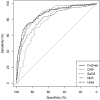Prediction of mortality and prioritisation to tertiary care using the 'OUR-ARCad' risk score gleaned from the second wave of COVID-19 pandemic-A retrospective cohort study from South India
- PMID: 39854588
- PMCID: PMC11761102
- DOI: 10.1371/journal.pone.0312993
Prediction of mortality and prioritisation to tertiary care using the 'OUR-ARCad' risk score gleaned from the second wave of COVID-19 pandemic-A retrospective cohort study from South India
Abstract
Background: Judicious utilisation of tertiary care facilities through appropriate risk stratification assumes priority, in a raging pandemic, of the nature of delta variant-predominated second wave of COVID-19 pandemic in India. Prioritisation of tertiary care, through a scientifically validated risk score, would maximise recovery without compromising individual safety, but importantly without straining the health system.
Methods: De-identified data of COVID-19 confirmed patients admitted to a tertiary care hospital in South India, between April 1, 2021 and July 31, 2021, corresponding to the peak of COVID-19 second wave, were analysed after segregating into 'survivors' or 'non-survivors' to evaluate the risk factors for COVID-19 mortality at admission and formulate a risk score with easily obtainable but clinically relevant parameters for accurate patient triaging. The predictive ability was ascertained by the area under the receiver operator characteristics (AUROC) and the goodness of fit by the Hosmer-Lemeshow test and validated using the bootstrap method.
Results: Of 617 COVID-19 patients (325 survivors, 292 non-survivors), treated as per prevailing national guidelines, with a slight male predilection (358/617 [58.0%]), fatalities in the age group above and below 50 years were (217/380 [57.1%]) and (75/237 [31.6%]), p<0.001. The relative distribution of the various parameters among survivors and non-survivors including self-reported comorbidities helped to derive the individual risk scores from parameters significant in the multivariable logistic regression. The 'OUR-ARCad' risk score components were-Oxygen saturation SaO2<94%-23, Urea > 40mg/dL-15, Neutrophil/Lymphocytic ratio >3-23, Age > 50 years-8, Pulse Rate >100-8 and Coronary Artery disease-15. A summated score above 50, mandated tertiary care management (sensitivity-90%, specificity-75%; AUC-0.89), validated in 2000 bootstrap dataset.
Conclusions: The OUR-ARCad risk score, could potentially maximize recovery in a raging COVID-19 pandemic, through prioritisation of tertiary care services, neither straining the health system nor compromising patient's safety, delivering and diverting care to those who needed the most.
Copyright: © 2025 Gopalan et al. This is an open access article distributed under the terms of the Creative Commons Attribution License, which permits unrestricted use, distribution, and reproduction in any medium, provided the original author and source are credited.
Conflict of interest statement
The authors have declared that no competing interests exist.
Figures



Similar articles
-
Predictors of mortality among hospitalized COVID-19 patients and risk score formulation for prioritizing tertiary care-An experience from South India.PLoS One. 2022 Feb 3;17(2):e0263471. doi: 10.1371/journal.pone.0263471. eCollection 2022. PLoS One. 2022. PMID: 35113971 Free PMC article.
-
Risk factors associated with intensive care unit (ICU) admission and in-hospital death among adults hospitalized with COVID-19: a two-center retrospective observational study in tertiary care hospitals.Emerg Radiol. 2021 Aug;28(4):691-697. doi: 10.1007/s10140-021-01903-8. Epub 2021 Feb 3. Emerg Radiol. 2021. PMID: 33534017 Free PMC article.
-
Epidemiological & clinical characteristics & early outcome of COVID-19 patients in a tertiary care teaching hospital in India: A preliminary analysis.Indian J Med Res. 2020 Jul & Aug;152(1 & 2):100-104. doi: 10.4103/ijmr.IJMR_2890_20. Indian J Med Res. 2020. PMID: 32811801 Free PMC article.
-
Multivariable mortality risk prediction using machine learning for COVID-19 patients at admission (AICOVID).Sci Rep. 2021 Jun 17;11(1):12801. doi: 10.1038/s41598-021-92146-7. Sci Rep. 2021. PMID: 34140592 Free PMC article.
-
Mortality among adult hospitalized patients during the first wave and second wave of COVID-19 pandemic at a tertiary care center in India.Monaldi Arch Chest Dis. 2021 Oct 11;92(2). doi: 10.4081/monaldi.2021.2034. Monaldi Arch Chest Dis. 2021. PMID: 34634900
References
-
- Gopalan N, Senthil S, Prabakar NL et al.. Predictors of mortality among hospitalized COVID-19 patients and risk score formulation for prioritizing tertiary care—An experience from South India. PLoS One [Internet]. 2022;17(2): e0263471. Available from: doi: 10.1371/journal.pone.0263471 - DOI - PMC - PubMed
-
- Khedar RS, Mittal K, Ambaliya HC et al.. Greater Covid-19 severity and mortality in hospitalized patients in second (delta variant) wave compared to the first: Single centre prospective study in India [Internet]. bioRxiv. 2021. Available from: 10.1101/2021.09.03.21263091. - DOI
MeSH terms
LinkOut - more resources
Full Text Sources
Medical
Miscellaneous

